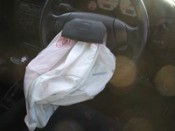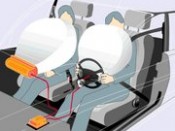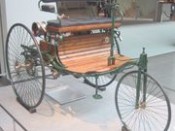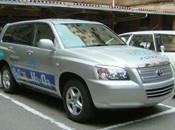
An automobile airbag, like this one in a crashed SEAT Ibiza car, deflates after 0.3 seconds.
An airbag, also known as a Supplementary/Secondary Restraint System (SRS) or as an Air Cushion Restraint System (ACRS), is a flexible membrane or envelope, inflatable to contain air or some other gas. Air bags are most commonly used for cushioning, in particular after very rapid inflation in the case of an automobile collision.
Airbag History
In 1952 the airbag was invented by John W. Hetrick and he patented the airbag the following year. It was an invention to help protect his own family using expertise from his naval engineering days.
There have been airbag-like devices for airplane as early as the 1940s, with the first patents filed in the 1950s.
The American inventor Allen Breed then developed a key component for automotive use – the ball-in-tube sensor for crash detection. He marketed this innovation first in 1967 to Chrysler. During this era, Americans were infrequent users of seat belts. A means of offering seat belt-like levels of occupant protection, to unbelted occupants, in a head-on collision was believed to be a valuable innovation.
Ford built an experimental fleet of cars with airbags in 1971. The first example of an airbag in a production car was in 1972 when the 1973 model Oldsmobile Toronado was released. In 1974, dual airbags were an option on several full-sized cars made by the Buick, Cadillac and Oldsmobile divisions. These devices did not meet with market acceptance.
The 1970s GM fleet of 10,000 airbag-equipped vehicles experienced seven fatalities. One death is now suspected to have been caused by the airbag. The crash severity was only moderate, and at the time a heart attack was suspected. The victim was cremated without an autopsy.
Then in 1980, Mercedes-Benz re-introduced the airbag in Germany as an option on its high end Mercedes-Benz W126, which also offered such other exotic options as hydropneumatic suspension. In the Mercedes system, the sensors would tighten the seat belts and then deploy the airbag on impact. From this point forward, the airbag was no longer marketed as a means of avoiding seat belts, but rather as a way to obtain an extra margin of occupant safety.
Airbags became common in the 1980s, with Chrysler and Ford introducing them in the mid-1980s. Ford made them standard equipment across its entire line in 1990. Autoliv, a worldwide leader in automotive safety systems, patented the side airbag and these safety systems began appearing in the mid-90s.
On July 11, 1984, the U.S. government required cars to have driver’s side air bags or automatic seat belts by 1989 (the automatic seat belt was a technology, now discarded, that “forced” motorists to wear seat belts). In 1998, dual front airbags were mandated by the National Highway Traffic Safety Administration (NHTSA), and de-powered, or second-generation air bags were also mandated. This was due to the injuries caused by first-generation air bags that were designed to be powerful enough to restrain people who were not wearing seat belts.
Despite the 1970s implementation of airbags in GM cars, many conventional automobiles did not even have them until the mid 1990s.
In 2006, Honda introduced the first motorcycle airbag safety system ever installed on a production motorcycle. The airbag was installed on its Gold Wing motorcycle.
Airbag Benefits
Air bags supplement the safety belt by reducing the chance that the occupant’s head and upper body will strike some part of the vehicle’s interior. They also help reduce the risk of serious injury by distributing crash forces more evenly across the occupant’s body.
“One recent study concluded that as many as 6,000 lives have been saved as a result of airbags.”
However, the exact number of lives saved is almost impossible to calculate.
Costs
Airbags cost about $500 per vehicle. If they are deployed in error or stolen, the motorist is required to repurchase them. Since they are an integral part of the vehicle design, it is not possible to retrofit airbags to a vehicle that does not have them.
Most manufacturers specify the replacement of undeployed airbags after, for example, 14 years to ensure their reliability in an accident. If the car is still on the road at this age, it would generally cost far more than the vehicle’s market value to have the airbags replaced.
Early Airbags: “Replacing” the Seat Belt
The standard shoulder belts were actually purposely omitted on the seventies cars with air bags since air bags were designed to replace seat belts in frontal impacts. The passenger side airbag on 1970s cars was located in the lower part of the dashpad and it also acted as a knee restraint. The lower part of the dash on the driver’s side was also different on cars with air bags, it was padded.
GM called this the Air Cushion Restraint System. The passenger side air bag in the seventies GM cars had two-stage deployment like newer air bags do.
The design is conceptually simple, accelerometers trigger the ignition of a gas generator propellant to very rapidly inflate a nylon fabric bag, which reduces the deceleration experienced by the passenger as they come to a stop in the crash situation. The bag has small vent holes to allow the propellant gas to be (relatively) slowly expelled from the bag as the occupant pushes against it.
Front air bags are not designed to deploy in side impact, rear impact or rollover crashes. Since air bags deploy only once and deflate quickly after the initial impact, they will not be beneficial during a subsequent collision. Safety belts help reduce the risk of injury in many types of crashes. They help to properly position occupants to maximize the air bag’s benefits and they help restrain occupants during the initial and any following collisions.
Although they were touted in the 1960s and 70s as a potential seat belt replacement, automobile airbags are now designed and sold as supplemental restraints; car designers have moved on from the initial view of the airbag as a seat belt replacement.
Airbag fatalities
Airbags involve the extremely rapid, violent deployment of a large object. While airbags can protect a person under the right circumstances, they can also injure or kill.
To protect occupants not wearing seat belts, U.S. airbag designs triggered much more quickly than airbags designed in other countries. As seat belt use in the U.S. climbed in the late 1980s and early 1990s, U.S. auto manufactures were required to adjust their designs.
Newer airbags trigger slightly less violent; nonetheless, passengers must remain at least 25 centimetres (10 in) from the bag to avoid injury from the bag in a crash.
In 1990, the first automotive fatality attributed to an airbag was reported, with deaths peaking in 1997 at 53 fatalities in the United States. TRW, an American corporation, produced the first gas-inflated airbag in 1994, with sensors and low-inflation-force bags becoming common soon afterwards. Dual-depth airbags appeared on passenger cars in 2005. By that time, deaths related to airbags had declined, with no adults deaths and 2 child deaths attributed to airbags that year. Injuries remain fairly common in accidents with an airbag deployment.
Smoking a pipe while driving should be avoided. If the airbag inflates and hits the pipe while it is in the mouth this may well be deadly, even if the impact is only moderate.
The increasing use of airbags has actually made rescue work for Firefighters, EMS and Police Officers more dangerous. Airbags can detonate long after the initial crash, injuring or even killing rescue workers who are inside the car. The addition of side impact airbags to the frame of the car has reduced the number of places that rescue workers can use hydraulic spreader-cutters (“the jaws of life”) or other similar cutting tools to remove the car roof, or doors safely. Every first responder should be properly trained on how to safely deactivate airbags or be aware of the potential hazards. Removing the car battery may be a good precaution.
In Europe the number of people not wearing their seatbelts is very small when compared to the United States, and Europeans are less likely to be obese. As a direct result of these two points, European airbags are less powerful than their American counterparts, and are therefore less likely to cause loss of life than the airbags fitted to American cars.
Airbag Design

An airbag system.
The air bag system consists of three basic parts: an air bag module, crash sensors and a diagnostic unit. Some systems may also have an on/off switch, which allows the air bag to be deactivated.
The air bag module contains both an inflator unit and the lightweight fabric air bag. The driver air bag module is located in the steering wheel hub, and the passenger air bag module is located in the instrument panel. When fully inflated, the driver air bag is approximately the diameter of a large beach ball. The passenger air bag can be two to three times larger since the distance between the right-front passenger and the instrument panel is much greater than the distance between the driver and the steering wheel.
The crash sensors are located either in the front of the vehicle and/or in the passenger compartment. Vehicles can have one or more crash sensors. The sensors are typically activated by forces generated in significant frontal or near-frontal crashes. Sensors measure deceleration, which is the rate at which the vehicle slows down. Because of this, the vehicle speed at which the sensors activate the air bag varies with the nature of the crash. Air bags are not designed to activate during sudden braking or while driving on rough or uneven surfaces. In fact, the maximum deceleration generated in the severest braking is only a small fraction of that necessary to activate the air bag system.
The diagnostic unit monitors the readiness of the air bag system. The unit is activated when the vehicle’s ignition is turned on. If the unit identifies a problem, a warning light alerts the driver to take the vehicle for examination of the air bag system. Most diagnostic units contain a device that stores enough electrical energy to deploy the air bag if the vehicle’s battery is destroyed very early in a crash sequence.
Some vehicles without rear seats, such as pickup trucks and convertibles, or with rear seats too small to accommodate rear-facing child safety seats, have manual on/off switches for the passenger air bag installed at the factory. These on/off switches for driver or passenger air bags may also be installed by qualified service personnel at the request of owners who meet government-specified criteria and who receive government permission.
Initially, most vehicles featured a single airbag, mounted in the steering wheel and protecting the driver of the car (who is the most at risk of injury). During the 1990s, airbags for front seat passengers, then separate side impact airbags placed between the door and occupants, became common.
Airbag Triggering Conditions
Airbags are typically designed to deploy in frontal and near-frontal collisions, which are comparable to hitting a solid barrier at approximately 8 to 14 miles per hour (13 to 23 km/h). Roughly speaking, a 14 mph (23 km/h) barrier collision is equivalent to striking a parked car of similar size across the full front of each vehicle at about 28 mph (45 km/h). This is because the parked car absorbs some of the energy of the crash, and is pushed by the striking vehicle. Unlike crash tests into barriers, real-world crashes typically occur at angles, and the crash forces usually are not evenly distributed across the front of the vehicle. Consequently, the relative speed between a striking and struck vehicle required to deploy the air bag, in a real-world crash, can be much higher than an equivalent barrier crash.
Because air bag sensors measure deceleration, vehicle speed and damage are not good indicators of whether an air bag should have deployed. Occasionally, air bags can deploy due to the vehicle’s undercarriage violently striking a low object protruding above the roadway surface. Despite the lack of visible front-end damage, high deceleration forces may occur in this type of crash, resulting in the deployment of the air bag.
The airbag sensor is a MEMS accelerometer, which is a small integrated circuit chip with integrated micromechanical elements. The microscopic mechanical element moves in response to rapid deceleration, and this motion causes a change in capacitance, which is detected by the electronics on the chip, which then sends a signal to fire the airbag. The most common MEMS accelerometer in use is the ADXL-50 by Analog Devices, but there are other MEMS manufacturers as well.
There was some work initially in mercury switches but they did not work very well. Before MEMS, the primary system used to deploy airbags was called a “rolamite”. A rolamite is a mechanical device, consisting of a roller suspended within a tensioned band. As a result of the particular geometry and material properties used, the roller is free to translate with very little friction or hysteresis. This device was developed at Sandia National Laboratories. The rolamite and similar macro-mechanical devices were used in air bags until the mid-1990s when they were universally replaced with MEMS.
Most air bags are designed to automatically deploy in the event of a vehicle fire when temperatures reach 300 to 400 degrees Fahrenheit (150 to 200 °C). This safety feature helps to ensure that such temperatures do not cause an explosion of the inflator unit within the air bag module.
Today, airbag triggering algorithms are becoming much more complex. They try to reduce useless deployments (for example, at low speed, no shocks should trigger the airbag to help reduce damage to the car interior in conditions where the seat belt would be an adequate safety device) and to adapt the deployment speed to the crash conditions. The algorithms are considered as very valuable intellectual property.
Airbag Deployment Mechanism
When there is a moderate to severe frontal crash that requires the frontal air bag to deploy, a signal is sent to the inflator unit within the air bag module. An igniter starts a chemical reaction, which produces a gas to fill the air bag, making the air bag deploy through the module cover. Some air bag technologies use nitrogen gas. A pellet of sodium azide (NaN3) is ignited. A rapid reaction occurs, generating nitrogen gas (N2) to fill the air bag. Potassium nitrate, and silicon dioxide are used in secondary and tertiary reactions to deal with the sodium that is liberated; first the potassium nitrate reacts with sodium, yielding sodium and potassium oxides and further gaseous nitrogen, then the oxides react with silicon dioxide, forming more or less inert glass particles. An alternative may use argon gas. Nitrogen and argon are both harmless. However, sodium azide as an aerosol is dangerous.
From the onset of the crash, the entire deployment and inflation process is faster than the blink of an eye. Airbags deploy in 15 milliseconds (0.015 seconds) for high speed crashes and in 25 milliseconds for low speed crashes (0.025 seconds). Because a vehicle changes speed so fast in a crash, air bags must inflate rapidly if they are to help reduce the risk of the occupant hitting the vehicle’s interior.
Once an air bag deploys, deflation begins immediately as the gas escapes through vents in the fabric. Deployment is frequently accompanied by the release of dust-like particles in the vehicle’s interior. Most of this dust consists of cornstarch or talcum powder, which are used to lubricate the air bag during deployment. Small amounts of sodium hydroxide may initially be present. This chemical can cause minor irritation to the eyes and/or open wounds; however, with exposure to air, it quickly turns into sodium bicarbonate (baking soda). Depending on the type of air bag system, potassium chloride (a table salt substitute) may also be present.
For most people, the only effect the dust may produce is some minor irritation of the throat and eyes. Generally, minor irritations only occur when the occupant remains in the vehicle for many minutes with the windows closed and no ventilation. However, some people with asthma may develop an asthmatic attack from inhaling the dust. With the onset of symptoms, asthmatics should treat themselves as advised by their doctor, then immediately seek medical treatment.
Once deployed, the air bag cannot be reused and should be replaced by an authorized service department. The vehicle can be driven after deployment, but there will be no supplemental restraint system until a replacement has been installed.
Air bags must inflate very rapidly to be effective, and therefore come out of the steering wheel hub or instrument panel with considerable force, generally at a speed over 180 mph (290 km/h). Because of this initial force, contact with a deploying air bag may cause injury. These air bag contact injuries, when they occur, are typically very minor abrasions or burns. The sound of air bag deployment is very loud, in the range of 165 to 175 decibels for 0.1 second. Hearing damage can result in some cases.
More serious injuries are rare; however, serious or even fatal injuries can occur when someone is very close to, or in direct contact with an air bag module when the air bag deploys. Such injuries may be sustained by unconscious drivers who are slumped over the steering wheel, unrestrained or improperly restrained occupants who slide forward in the seat during pre-crash braking, and even properly restrained drivers who sit very close to the steering wheel. Objects must never be attached to an air bag module or placed loose on or near an air bag module, since they can be propelled with great force by a deploying air bag, potentially causing serious injuries.
An unrestrained or improperly restrained occupant can be seriously injured or killed by a deploying air bag. The National Highway Traffic Safety Administration (NHTSA) recommends drivers sit with at least 10 inches (254 mm) between the center of their breastbone and the center of the steering wheel. Children under 12 should always be properly restrained in a rear seat. A rear-facing infant restraint must never be put in the front seat of a vehicle with a front passenger air bag. A rear-facing infant restraint places an infant’s head close to the air bag module, which can cause severe head injuries or death if the air bag deploys. Modern cars include a switch to turn off the airbag system of the passenger seat, in which case a child-supporting seat must be installed.
Advanced Airbag Design
Many advanced air bag technologies are being developed to tailor air bag deployment to the severity of the crash, the size and posture of the vehicle occupant, belt usage and how close that person is to the air bag module. Many of these systems will use multi-stage inflators that deploy less forcefully in stages in moderate crashes than in very severe crashes. Occupant sensing devices let the air bag diagnostic unit know if someone is occupying a seat in front of an air bag, whether the person is an adult or a child, whether a seat belt or child safety seat is being used and whether the person is forward in the seat and close to the air bag module. Based on this information and crash severity information, the air bag is deployed at either a high force level, a less forceful level or not at all.
Many new vehicles are also equipped with side air bags. While there are several types of side air bags, all are designed to reduce the risk of injury in moderate to severe side impact crashes. These air bags are generally located in the outboard edge of the seat back, in the door or in the roof rail above the door.
Seat and door-mounted air bags all provide upper body protection. Some also extend upwards to provide head protection. Two types of side air bags, known as inflatable tubular structures and inflatable curtains, are specifically designed to reduce the risk of head injury and/or help keep the head and upper body inside the vehicle. A few vehicles are now being equipped with a different type of inflatable curtain designed to help reduce injury and ejection from the vehicle in rollover crashes.







